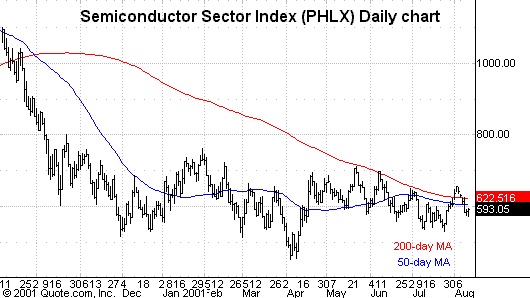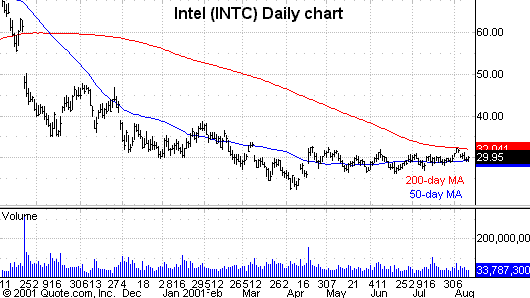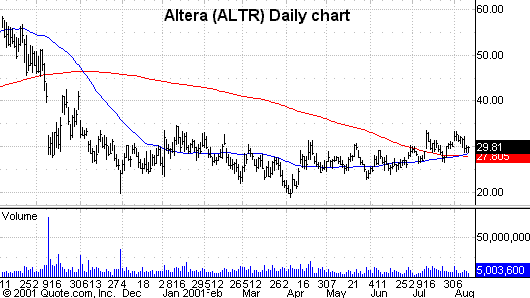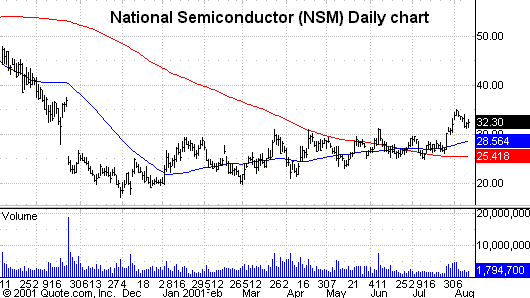No Visibility?
The Nasdaq briefly dipped below
its July lows Friday but managed to bounce constructively
back from its lows for a decent close. As for the future direction
of the tech sector, don’t bother looking to company CEOs or analysts
for answers because the only pearls of wisdom any of them have to offer
is that there’s just “no visibility” about the future.
I am sure getting tired of the excessive use of that term
which, if you think about it,
actually means that Reg FD is working extremely well in leveling
the playing field between investors and the white-shoe analysts. “Whisper”
numbers are long gone, and it’s very clear that company managements are terrified of lawsuits that could originate
if they give analysts any hints
about the future of their businesses. Of
all the tech sectors, one of the cloudiest groups “lacking visibility”
is the chip sector.
Last week,
Merrill Lynch temporarily fired up the semiconductor
group when it said the worst was over for the beleaguered sector
and that recovery was on the way. Then early this week CS First Boston
threw water on the chip fire saying that things could actually get worse before they get better. The
(
SOX |
Quote |
Chart |
News |
PowerRating)
gave back most of last week’s gains this
week and finished back below its 50- and 200-day moving average, but the fact the SOX refused to dip to its July
lows was a positive.

In addition to the CSFB downgrade, Lehman Brothers’ Intel
(
INTC |
Quote |
Chart |
News |
PowerRating) guru Dan Niles warned
that Intel might be thrown into a brutal price war with Advanced Micro
(
AMD |
Quote |
Chart |
News |
PowerRating) that would put Intel’s Pentium 4 chips under tremendous pricing
pressures. We need only look at the tight,
back-and-forth trading range Intel
has remained in since mid-April. It’s continued to hug its 50-day moving
average and clearly has to move back above its 200-day moving average for buyers to step in.

I’m focusing on the chip group because in most tech
recoveries, the semis lead the
way since they play such an integral part in the mechanics of the technology
cycle. Why is the recovery taking so long given the six Fed rate cuts?
Well, there was a great cover story in Business Week titled “Lessons From The Telecom Mess,” and it basically said
that the Telecommunications Act of 1996
has turned out to be a dud.
Instead of deregulation, it protected local
phone companies who control 96% of
local phone lines. They have stymied the broadband revolution and forced many DSL providers out of business. Broadband
cable operators have also failed
to make it easy enough for consumers to move to broadband lines. Sadly,
five years after the Telco Act, less than 5% of households have broadband
access. The Business Week article offers some solutions and says that the entrenched interests need to be
shaken up drastically before the revolution
can continue.
Who will shake things up? Well, it’s going to have to come
partly from Washington and
partly from state and federal regulators. It’s not going to be
simple given all the conflicting interests involved. AOL President Steve Case said several years back that the future
of the Internet would be decided
in Washington, and he was right. In order for the tech revolution to continue, more “wrenching” changes
must take place. Unfortunately, knowing how
Washington works, it could take a long, long time.
In the meantime, keep an eye on the chips
because they will be the initial movers
that the rest of tech will follow. Several SOX components that look interesting right now are Altera
(
ALTR |
Quote |
Chart |
News |
PowerRating),
National Semi
(
NSM |
Quote |
Chart |
News |
PowerRating) and Motorola
(
MOT |
Quote |
Chart |
News |
PowerRating).
Each is in an uptrend, and each is above its 50- and 200-day moving averages.



Have a great weekend!
